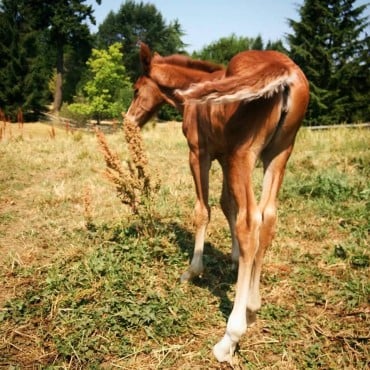
So how can we provide this kind of natural plant and herb variety for our domestic horses?
Doctor gardens
Some people set aside a ‘doctor garden’ enclosure in their equine permaculture system to provide this variety, and allow their horses in there for a half hour a day to forage and self-medicate as they wish. Others plant various herbs around their fields.
Honeyvale Herbs in South Africa has a great handout on how to organize your field and which herbs, plants, and bushes to plant where. Along with a good selection of plants to offer your horses. You can download it here.
A good resource for which plants to avoid and which herbs are toxic for horses is found here.
Portable fresh herb feeders
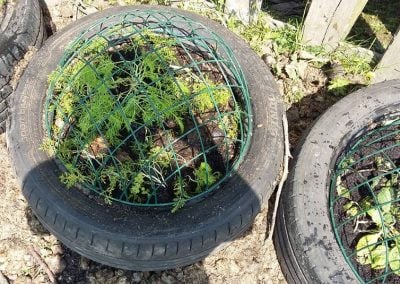
Another great way to offer free-choice, fresh herbs to your horses is to plant them in old tires with upturned hanging baskets over top. The basket protects the plant so the horses cannot decimate it; but they can nibble off leaves as the plant gets big enough to poke through the mesh of the basket.
You simply fill an old tire with soil and plant your seeds. Drill holes in the tire and then secure the upturned hanging basket to the tire with cable ties.
If you can’t find baskets that are a similar size to the old tires that you have, or vice-versa – just substitute wooden or plastic planter boxes from Home Depot or plant stores. Or try to find some plastic or wire mesh baskets from gardening centers, or closet organizers, or kitchenware stores.
Lindsay Howard-Dean placed her herb feeders off the ground so their dogs wouldn’t “water” them:
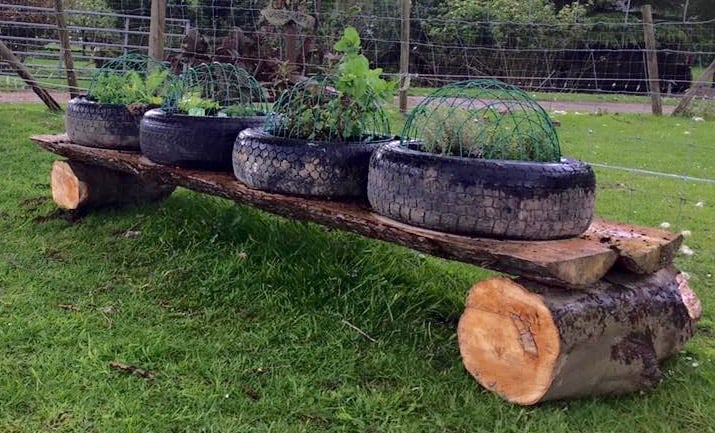
Dried herb blends – Safe for Horses
Having neither a doctor garden, nor portable herb feeders, I first tried giving my horses a variety of cut, fresh herbs to choose from – that horse herbalists have recommended – but they ate little to none of them!
What has worked for my herd is to give them dried herbs sprinkled on their feed, or offered singly. I sometimes buy the Respiration, De-Tox and Stop Itch blends from Wendals – and I don’t necessarily use them for the purpose their name suggests! For example, the Stop Itch is actually an excellent immune booster blend. My horses would also eat these right out of the tub if I let them (yes, I’ve tested this! Except for the Stop Itch blend, which they like the least, but they will still eat grudgingly).
I also bulk buy dried herbs – that I have researched and I know are safe herbs for horses to consume – from Mountain Rose Herbs and give these as my intuition/knowledge guides me, or as the horses ask for them:
- Echinacea
- Calendula
- Plantain Leaf
- Peppermint Leaf
- Parsley Leaf
- Marshmallow Leaf
- Chamomile Flowers
- Lemon Balm
- Goldenseal Leaf
- Meadowsweet Herb
- Marjoram
- Coltsfoot
- Yarrow
- Comfrey Leaf
- Raspberry Leaf
- Strawberry Leaf
- Astragalus Powder*
- Dulse Flakes
- Kelp Powder
I tested each of them singly first to see whether my horses would eat them and then I mix them together (in varying proportions according to the herb) in a large tub. I give 1/2 cup – 1 cup per feed, as needed. All 4 of my equines love to eat their herbs this way.
*The astragalus powder I dose separately – at 1 tbsp. per feed – only when needed, as it is a powerful immune booster than can induce a fever.
The dulse I mix in with the kelp powder (or SeaBoost seaweed) and sprinkle 1 tbsp. over their feed. I particularly like the dulse flakes as they have the most varied mineral mix of all the seaweeds.
So these dried herbs are my solution to currently not having a doctor garden, or naturally growing herbs for my horses to forage for themselves. When I get my own land, I will definitely plant a good mixture of herbs and plants that horses would naturally forage for in this climate. Mountain Rose Herbs also sells a good selection of organic medicinal seeds.
In fact, you know what? Right now, this moment here, I’m changing my mind! I’m moving my herd to a new pasture in a couple of weeks and I should be able to keep them there for at least a year. So. I’m going to plant some forage herbs for the horses this Spring and see how that works; what they eat, or don’t eat, what they prefer, etc.
Medicinal & other edible plants for equines in UK or Pacific Northwest
Dr. Carol Michael PhD in the UK recommends making these plants (which contain antimicrobials, saponins, antioxidants, Vitamin E, C, anti-obesity compounds etc.) available to your horse – either in their fields, or gather them and put a selection in their stalls. All these plants grow in rainy climates like the UK and the Pacific Northwest:
- Moss (attached to a twig, wall or in the grass)
- Wild geranium
- Self-heal (also called Prunella) – it’s quite bitter so only feed the leaves when first introducing.
- Cleavers (goose grass) – again cut into small pieces when first introducing.
- Heather (Calluna vulgaris)
- Trefoil (part of the alfalfa family)
- Sweet verbena (choose small plants and feed leaves only when first introducing)
- Juncus
- Vaccinium (wild blueberry)
- Wild bulrush
- Sorrel (only some horses like this)
Plants that grow near water are sweeter than plants near rocks or dry areas, so start with those first when introducing a horse to forage.
Domestic versus feral horses
One interesting point to mention is that I have seen a big difference in the variety of plants and trees my semi-feral horses will eat versus my domestic horses. My wildies are also more likely to try plants or leaves, and spit them out if they don’t like them, whereas the domestic horses won’t even take a bite.
Having said that, a friend of mine noticed that when she moved her domestic horses to a wild, unmanaged chunk of land, her horses gradually became bolder and consumed a larger variety of plants as the months went on – even thistles! So it’s very encouraging to know that horses can re-wild themselves when given the chance. Dr. Michael noticed the same thing with domestic horses in the UK when they were turned out into larger, wilder fields and given the chance to forage.
As it is far cheaper to purchase seeds, plant them, and let your horses forage and self-medicate, this is definitely a good route to go and don’t worry whether your horses don’t eat much for the first few months. Just give them time and they will gradually begin to try and eat a wider variety of plants.

Jini Patel Thompson is a natural health writer and Lazer Tapping instructor. She began riding at age 2 in Kenya, and got her first horse at age 8 in Alberta, and so continues a life-long journey and love affair with these amazing creatures.

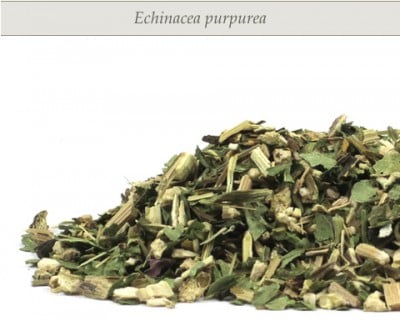
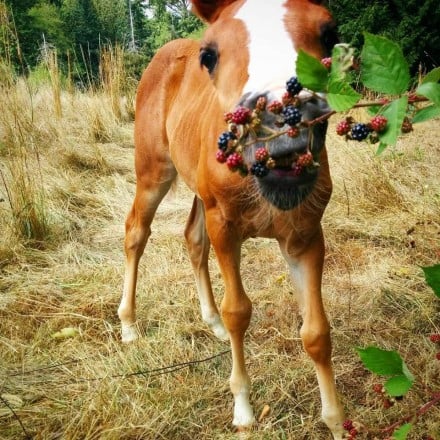
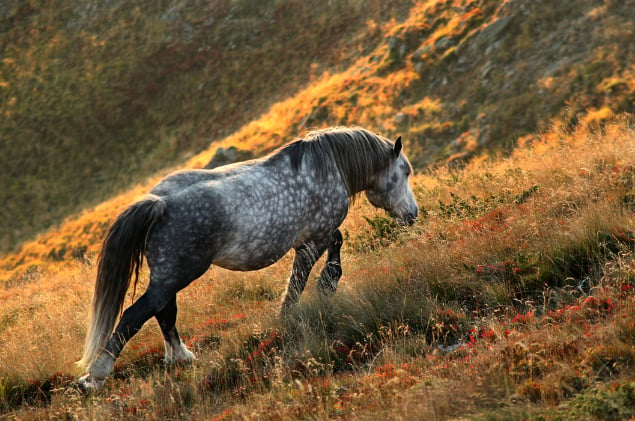







Some great ideas, here. You left out a number of plants that I know horses in the UK choose to eat regularly, including: hawthorn, yarrow, dandelion and wild rose.
Allowing horses to self-select is always best. I. too, go the “dried herbs in feed by intuition” route, because I know my horses pretty well. However, allowing them to self-select single, unblended, herbs is still the best way, I believe, and within reason, allowing them to determine the amount they want to consume, and for how many days, is also helpful, particularly if you are offering herbs in an effort to sort out an illness/imbalance. A horse may eat a surprisingly large (or small) amount of something for only one or two days, and then they are done, whereas we humans tend to go for the “little and often” approach.
Another thing to consider is that horses can kill off some of the plants that are best for them in their pasture. Even more of a problem if they are newly planted. Planting horse-friendly native plants in places where they can only nibble at them over or under a fence can help.
If you are really interested in how horses self-select plants for health, you should have a look at the work of Caroline Ingraham (if you haven’t already). Her little book “Aromatherapy for Horses” is inexpensive, and discusses self-selection of essential oils, but can also be applied to herbs. Her “How Animals Heal Themselves” is more comprehensive.
Thanks again for a great article!
Thank you so much for the book suggestions Kris – “How Animals Heal Themselves” is going to go into my next Amazon order! I just purchased “The Complete Herbal Handbook for Farm and Stable” by Juliette Bairacli Levy after hearing some good things about it. I’ll post a review after I’ve gone through it – but it looks good from my first flip-through.
I also like your idea of planting the ones they love in harder to reach places – very good suggestion, so they can still eat them, but not decimate the plants. And yes, I totally agree with your summary of why self-selection is best. Absolutely.
Another excellent book is Herbal Housekeeping by Robert McDowell.
Totally agree with Kris, self-selection is best and in the long run most economical, if your horses don’t have access to wild stuff. In my experience there are no herbs that horses always want when given the choice, so no point feeding them. And the level of self-regulation is phenomenal. Caroline Ingraham’s book is great, and the science behind that is a book called Wild Health by Cindy Engel. Highly recommended.
Nayana’s comment just appeared in my email, and I want to add a few more thoughts. Even putting self selection to one side, for a moment, it is important to know more about the herbs you feed than just that “horses eat these in habitats where they are available”. It is rare, for example, for most non-grasses to be available in all seasons, and horses tend to choose most herbs seasonally. That may be due to something as simple as there being more sugar available (rose hips in early winter) to possibly serving a seasonal need (hawthorn regulating digital circulation in spring, when grass laminitis is most common) or simply because the herb is green when little else is. So it is important to know when and possibly why horses eat what they do, but even more to understand the importance of not feeding (or taking) any herb all the time. The potential for liver and kidney damage, among other things, becomes a question. Self selection usually regulates this, but there are times when I do rein in my desire to treat some condition, or tell the pony who wants to eat licorice root by the half-pound on a daily basis, that we need to re-think this! If there is an ongoing condition of some kind, then rotating treatments is so important.
When I delve deeper into discussions like this, I find myself running back to the safety of “homeopathic level” herb dosing! I figure, if I give 1/2 cup only 2-3x/week then I’m unlikely to do any damage. But if the horse needs that herb, then their body can use it in a resonance/vibrational way. And of course, the ideal is to plant a “doctor garden” and let them self-select, rather than taking additional training and educating myself sufficiently to dispense reliably!
My horses’ paddocks have hedgerows on 3 sides which by the end of each season are decimated before the horses are rotated into the other paddocks. Here is a list of what is and is not eaten by the horses:
Brambles (leaves and fruit), goose grass, apples (leaves and fruit straight off the tree), hawthorn (usually leaves and occasionally fruit), nettles, thistle flowers, ash tree leaves, elder leaves (never the fruit). We have had to fence off the maple trees because if we don’t they strip the bark.
So do you mean they eat stinging nettles FRESH? I didn’t know that! They must not get the same effects from the plant that we do…
Young nettle plants do not have the stinging effect as mature plants – my horse will eat young plants.
That’s interesting, I never observed horse eating young stinging nettles when I lived near them.What I did see was horses consuming huge quantities of them as soon as they were frost killed, or if I decided to scythe them down in places. (They lose their sting as soon as they wilt.)
I LOVE stinging nettles. I crush it up raw and use it as tea. mix with raspberry, (fruit) canadian thistle blooms. Sweet, fruity, helps with allergies, and congestion.
I once had a pony that was eating fresh, fully grown “big” nettles by the numbers when there was little grass left. He would pick the at the base munch them stem first, one after another. If you stroke a nettle from bottom to top they don’t sting. He seemed to know that.
Hello all – just updated this post with a whole new list of herbs that are safe for horses, along with a PDF download from Honeyvale Herbs – which is a great guide to planting/organizing your own horse herb garden. Enjoy!
Living in the Southwest desert there really is no “pasture” and fresh herbs can be difficult,to grow. I do provide the best quality Bermuda hay available (low sugar/starch, moderate protein), Timothy pellets from the Midwest for variety and like adding dried herbs from Mountain Rose. And my ponies do browse! – on mesquite catkins in the spring, mesquite beans and prickly pear cactus fruit in the summer and prickly pear cactus pads year round. In rainy season they discover tufts of native grasses. A local rancher has a herd of “movie” horses – you’ve likely seen them on TV – who spend their non-working time running loose on a few hundred acres of mainly scrub desert with a little supplemental hay and salt and a fresh water supply. They are some of the healthiest horses I’ve ever seen and what convinced me that the best supplement we can give our horses,is freedom and space.
Oh a hundred Amens to that Patti!! That’s my dream – to have a few hundred acres for my herd! Kesia has just managed to make that happen:
https://www.listentoyourhorse.com/rewilding-the-herd-the-beginning/
So I’m going to live vicariously through her, for now…
i also live in the south west and have cactus in my horses field. one horse is a mustang. i have never noticed the cactus being eaten and im shocked that they would. interesting. i have witnessed them eating stinging nettle once but afterwards they held their top lip up and wouldnt eat it any more
My horses get a multi vitamin in their grain and there’s a vitamin mineral in the hay.. If giving herbs is that going to give them to many vitamin and minerals ?
Well, when you consider that horses in a natural environment consume at least 25 different plants each day – I can’t see how giving more plant variety (fresh or dried) is going to do any harm. Remember, you can always offer them singly and let the horse choose how much they want.
Pingback: The Empowered Mustang Project: Self-Healing & Integration | Listen To Your Horse
Can horses eat the herb called Rocket?
I don’t see how that would be a problem. Most of my horses eat different kinds of lettuce and various leafy herbs – cilantro is one none of them will eat. Here is a list you can use for guidance:
https://esc.rutgers.edu/fact_sheet/odd-things-that-horses-eat/
If your horse is out in nature with either enough pasture to forage a variety of food items, or, you take your horse out for walks where s/he can forage freely, then your horse will likely have it’s own wisdom for what is okay to eat and in what quantity, and at what stage of plant growth. So then you could offer the rocket (or any new plant) on it’s own – just put some on the ground – and see what happens. BUT if your horse is confined to a stable, paddock, or just flat grass turnout, then they are pretty cut off from their own body wisdom, so best to be more careful. Hope that helps!
Hello,
Thanks for your blog and all those that have contributed.
Can you please comment of orange segments being consumed.
My horse love mandarins and oranges.
I gave him approx 4 segments from a whole orange the other day.
We have shared 1/2 a mandarin each.
Thanks for your time.
Yes, all of my horses love oranges AND the peel too. They will even eat the peel on it’s own, or the flesh on it’s own – they love it all 🙂
Hi,
I am confused to see sorrel in the list of medicinal plants as I have often found it amongst toxic plants for horses.an you clarify this for me please?
Hi Alison – That list was given by Dr. Carol Michael. I did a little research and it seems that sorrel is only an issue if eaten in large amounts, in a short period of time:
http://www.horsedvm.com/poisonous/sorrel/
However, I also found this VERY interesting account from a veterinary article in 1921:
“Recently I observed a great deal of this plant in Alabama, but I heard of no cases of poisoning from the plant. The patience dock and common sorrel have long been used like pie plant. I do not recall cases of poisonong from these plants. The sheep sorrel is an extremely common seed on acid gravely and sandy soils in the north, Michigan, Wisconsin and Illinois, where the fields are fairly yellow when the plant is in bloom (May 27, 1921). Apparently cattle, sheep and horses in some pastures avoid the plant. I have before me an interesting article by Dr. J. F. Craig of Ireland on the poisonous nature of common sorrel – the Journal of Comparative Pathology and Therapeutics, 34:27, 1 f., 1921¿ (Rumex acetosa) in which it is shown that this plant has .1575 percent oxalic acid and it occurs in the form of binoxalate potash. The author conducted six experiments with four young cattle about seven months old, two heifers, two bullocks which were fed with the fresh sheep sorrel. Some refused to eat it, or ate it only sparingly. One bull ate 237 pounds of sorrel from the 29th of April to the 29th of May. At no time did the bull show any injurious effects. Though suspected of being poisonous in pastures near Dublin, the author says it is unlikely that they would have picked up the quantity fed to one of the animals. The experiments do not support the view that the common sorrel is poisonous. It is possible, of course, that the amount of oxalates or other toxic substances present in the common sorrel may vary in different years and that such variation might affect the result of experiments.” Source: https://www.accessdata.fda.gov/scripts/plantox/detail.cfm?id=20879
Thank you so much for the interesting information Jini, and for doing all that research.We grow our own hay ,just for one horse , and there are patches where the sorrel takes over.When they are big I pull them out but the small young plants, there are just too many to even make a difference.I have mowed these patches all spring so that none gets in the hay.There is also a bit of sorrel growing in the field, but now after reading your reply I can relax a bit about that!Again many thanks and I really enjoy reading and learning on your page.
You’re very welcome! But see, that’s another aspect that is not usually addressed in the literature – the difference between consuming a young (or springtime) plant and a mature plant. I’ve noticed my horses will eat a lot of ferns (for eg) in the spring, with the new young growth, and they mostly like the tips. But in summer, they don’t touch them much, if at all.
For hay growers it would be nice to have more exact info available, for sure!
I think it was really helpful!
I am turning 12 in december and I am trying to earn enuogh mouny and learn more about horses but I still need over 7,000 (wich I am no where near🤪) if I want the horse I am looking at (wich I really do!).
thank you!
🙂
That’s about what people save to buy a car 😉 But remember, it isn’t the purchase price of the horse that’s the most expensive, it’s the ongoing costs. Sometimes it’s good to plan, and sometimes it’s good to just go for it, and figure it out as you go along. Listen to your gut!
I am trying to feed my horse some herbal supplements similar to Crypto Line and Metabolism without having to pay so much for them. With that in mind, I am just buying the herbs. However, I need some guidance on how much to feed the following: seaweed, tumeric, spirulina, yarrow, and chia seeds. Do you have a source for this information? Or do you know off hand? I have seen so far that large quantities of iodine from seaweed can be bad, but that is about all I can find. Thanks!
Hi Sydney,
Here’s what I do:
seaweed – 1 tbsp per day or every other day
spirulina – only when needed and then 1/2 tsp.
turmeric – free choice – can also feed fresh turmeric root
yarrow – free choice
Chia seeds – if not feeding flax or hemp, then 1/2 cup
Let us know how it goes!
Hi dose anyone know if horses can eat chia plants
This gives a good overview: https://cooking.stackexchange.com/questions/58703/can-i-eat-chia-leaves
can i feed my horse fresh dill i purchased out of the grocery store?
Hi Sherri – you can check whether any plant is non-toxic by following the link I gave in the post. So for all plants that start with “D” you can see that Dill is not on the list:
http://www.theequinest.com/care/toxic-plants/d/
Therefore there is no known toxicity. Of course, your horse also may not like/want dill – so best to offer it “free choice”. This means you offer the plain dill in your hand or in a dish and see if your horse wants it or wants to try it. You can offer it a few times. But don’t try to hide it or mask it with molasses or other things you know your horse likes. Have fun!